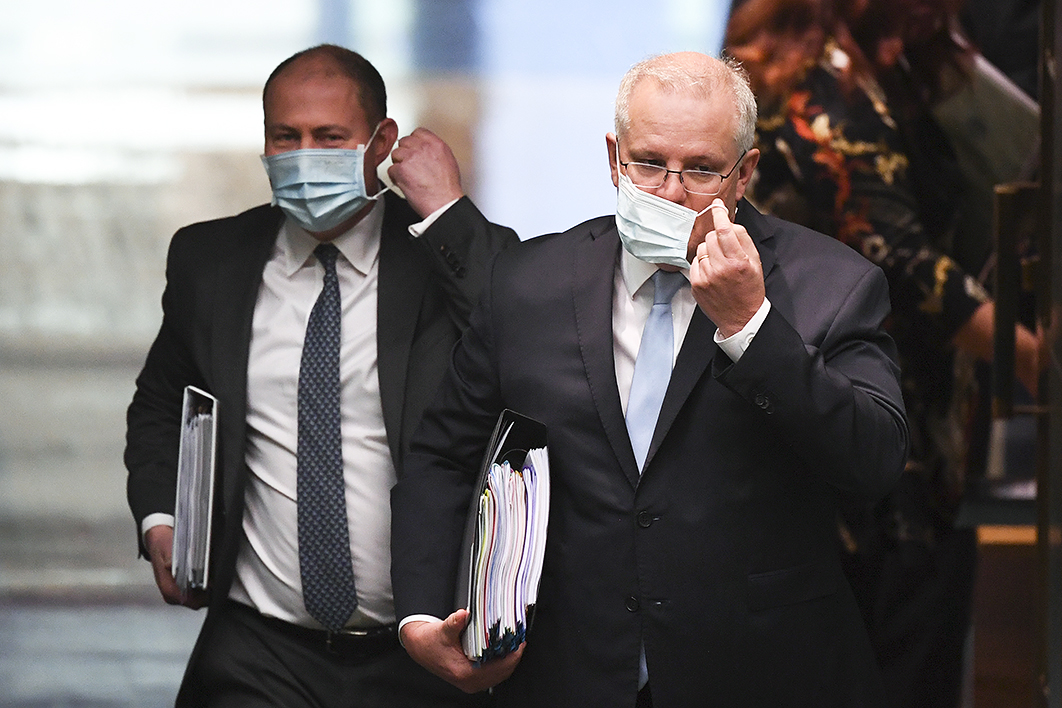There’s nothing like a 7 per cent quarter-on-quarter decline in GDP to focus the mind. It has prompted the government to consider bringing forward its three-stage tax cuts to boost demand and support the economy. This makes sense if parliament was going to approve the tax cuts anyway. But if parliament had reservations about whether they are a good idea, the argument that they are a good form of fiscal stimulus is a weak one that shouldn’t change its thinking.
There are several reasons for this. First, these tax cuts are a permanent solution to a temporary problem. Covid-19 will certainly have long-run consequences, but the major impacts that necessitate stimulus are temporary. Tax cuts are not. They represent a permanent, structural reduction in the size of the federal budget. This is fine if the demands on government spending are expected to be smaller in the future. But an ageing population and years of alarm bells in Treasury’s Intergenerational Reports suggest the opposite — and this isn’t even including big new spending proposals to deal with challenges ranging from climate change and aged care to dental, childcare and mental health supports.
Second, these tax cuts are poorly targeted to the people who have been hit hardest by Covid-19. Tax cuts aren’t much help when you don’t have a job. The combined three-stage tax cuts provide little assistance to the poor and unemployed while favouring the rich. A part-time worker earning $30,000 a year will secure just $255 a year from the planned tax cuts while someone on the prime minister’s salary will ultimately see an $11,640 annual benefit. It’s not surprising that tax cuts favour the rich given the rich pay most of the tax: the top 5 per cent of income earners will pay more than a third of the total tax collected in Australia in 2024–25. But the fact that low-paid workers are the ones bearing the brunt of Covid-19 makes these tax cuts a poorly targeted support program.
Third, the poorly targeted nature of these tax cuts makes them a weak form of stimulus. Rich people save more and spend less of their income than poorer people. Since more than 60 per cent of the total cost of these tax cuts through to 2029–30 come from stage three, which benefit people on high incomes the most, the majority of this stimulus will be saved, not spent. Research from the United States shows why this is a bad idea. The boost to GDP from tax cuts that favour the rich is less than one-quarter of that which comes from other forms of stimulus, including transfers to individuals, transfers to state governments for infrastructure, and purchases of goods and services by the government.
Finally, tax cuts will not only worsen inequality, they will also exacerbate the low-growth, low-inflation, low-interest-rate, low-investment economy we struggled with pre-Covid-19. Economists Atif Mian, Ludwig Straub and Amir Sufi show how diverting more national income away from the poor in favour of the rich fuels increased savings while reducing spending. This results in exactly what we’ve seen in recent years: lower inflation, lower interest rates, increased household debt, and lower investment and growth. Diverting even more resources towards wealthier Australians through these tax cuts will continue this cycle of increased savings by the rich and increased debt among the poor as they struggle to keep up, spurred on by low interest rates.
The biggest problem with these tax cuts is that there are better ways to stimulate the economy. The best fiscal stimulus is the kind we don’t regret later on; it’s stimulus that boosts the economy while tackling long-run challenges we’ve been reluctant to address because of the spending it would entail.
Public housing is an obvious option. With the pre-Covid-19 shortfall in homes estimated at 650,000, increasing the supply of public housing stimulates the construction sector, deals with a long-run challenge and, best of all, leaves the government with valuable assets on its balance sheet. An even bigger bang-for-government-buck could come from increasing rent assistance, releasing more land for housing construction, and easing restrictions on the number of tenants and the eligibility of public housing tenants.
Infrastructure is the best and worst form of stimulus: it boosts short-term demand and long-term productivity but takes too long to plan, prepare and build to be useful. But a balance can be struck by directing funds to state and local governments for infrastructure repairs and small-scale projects. And if Covid-19 permanently boosts the digital economy, then commencing longer-run projects to improve the NBN and access to the internet, software and hardware make sense, and would lock in near-zero interest rates for high-return investments.
The other big long-run challenge that needs funding is climate change. The best solution to climate change is pricing carbon, not a Green New Deal; but with interest rates at rock bottom, government spending can help encourage household investments in insulation, double glazing, energy-efficient lighting, energy-efficient water heating and solar panelling (while learning the lessons from the pink batts disaster during the global financial crisis).
Each of these ideas is a better form of stimulus than tax cuts. But if the government is committed to implementing tax cuts, now is the time to combine them with substantive reform. Much could be done in reforming the tax and welfare systems to improve their efficiency and fairness, increase incentives to invest and work, and ease the cost of doing business. The usual challenge with tax reform is that it creates winners and losers, the latter of which tend to oppose the reform process. Combining tough reforms with crowd-pleasing tax cuts is a practical way to build support for the measures.
Implementing tax cuts without broader reform is not only a poor form of stimulus, it is a missed opportunity. We can do better. •




